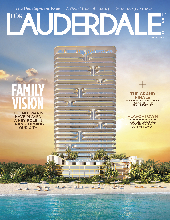When the wrecking ball went to work on the two-decades-old Las Olas Riverfront entertainment complex in 2017, plans were already forming for what would come next on the prime riverfront site. Now, the first residents are settling into Society Las Olas.
The massive project’s first phase includes 639 residential units, 30,000 square feet of ground floor space for restaurants, entertainment and services and a lifestyle approach that values community and communal spaces over more traditional markers of new apartment desirability such as square feet. Rents start around $1,100 and are typically in the $1,300-to-$1,900 range.
“We achieve the lower pricing because we do have some smaller layouts,” says Brian Koles, director of brand and marketing for PMG, the company behind the project. They offset that, he says, with those communal spaces as well as – in normal, non-COVID times – event programming. The people behind this project are also aware of what’s come before.

“Many people on our team knew the Riverfront entertainment district when we were growing up,” Koles says. “We took it as a great responsibility to revitalize that part of the riverfront as something that would make the city proud. That responsibility weighed heavily on us, and so we’re super proud of the way it’s been received. We love showing people around.”
There’s plenty to show. Phase one of the project is already massive; by the time phase two is complete, Society Las Olas will have about 1,200 residential units and, according to PMG, be the largest co-living development in the US.
That size is crucial to making the co-living experience work, Koles says. It’s an experience based around everything from communal kitchens, yoga lawns and performance stages to salons and gyms. Events from culinary classes to professional networking are also meant to foster that sense of community. To do that, you need a certain number of people.

“If there’s less than, say, 300 beds, then it becomes difficult to get the impact we go for,” Koles says. “The spaces may not be large enough to gather 50 or so people comfortably. And the pool of people you’re pulling from is smaller. You don’t really get that critical mass that makes for a memorable environment, and you don’t get the spaces that really bring people together.”
Much of the social side of Society Las Olas will, like so much else in the world, be put on hold for now. But if the pandemic puts some of the building’s amenities temporarily into more limited use, Koles believes it also offers a good reminder as to the value of diverse real estate. “In the world of real estate, our timing for COVID, business-wise, has been very fortunate in that most of our focus is on leasing up attainably priced rental units,” he says. “We’re not currently sitting on a bunch of condo inventory that’s a bit more challenging to move right now. The project is performing at pre-COVID expectations for leasing velocity and pricing.”

Society Las Olas’ location in the middle of a downtown that has traditionally been more focused on office space is typical of what PMG seeks out around the country. “We look for major cities with an oversupply of traditional luxury housing,” Koles says. Places with downtown office canyons and new multifamily construction dominated by condos for residents with six-figure salaries are what PMG wants to find.
“They tend to be not addressing the incomes of, say, $60,000 to $100,000,” he says. “The great thing about Fort Lauderdale is that there’s an influx of population and there’s a healthy job base. But there just hasn’t been a supply of housing to help meet that.”
Koles also cautions against making too many assumptions about who moves into a place like Society Las Olas. Yes, it caters to many Millennials who value things like walkability and community over square feet.

“We do tend to draw a lot of young professionals because of the rent prices,” Koles says. “But we are very focused on being inclusive – you’d be surprised at the age range we have.”
They draw plenty of people in their 40s and 50s.
“They just want to live really conveniently and be close to the city,” he says.
For something like Society Las Olas to work, it also has to offer that community in a way that’s actually, well, a community. PMG tries to approach what Koles calls “the amenities arms race” with practical goals in mind, not just stuff that looks good in a brochure and sounds good on a tour.

“What makes us different is we design amenities to use as part of daily life,” he says. “We design a gym that is a true replacement for a private health club and a co-working space that a large percentage of residents actually work out of every day.”
That sort of daily-use community – even if it’s not running fully during a pandemic – is something people respond to, Koles says.
“People are craving that; they want to know their neighbors,” he says. “We’re signaling to people, it’s okay to say hi and get to know your neighbors. Humans have always lived in villages and supported each other.
“People have really gotten away from knowing and supporting their neighbors.”














